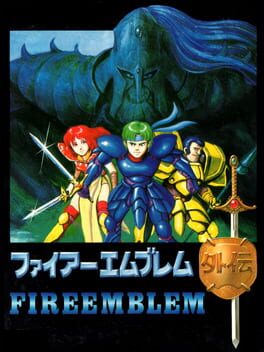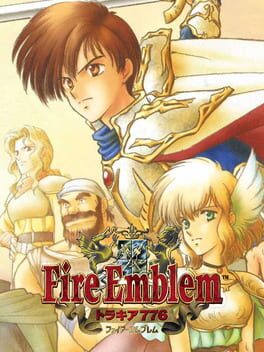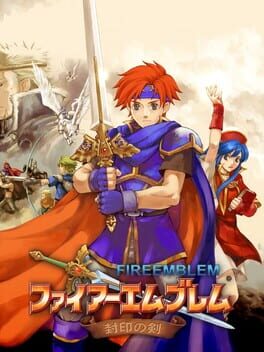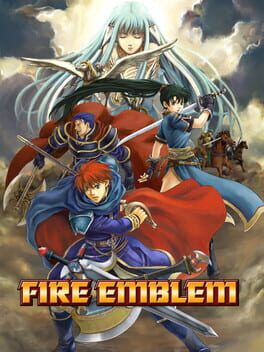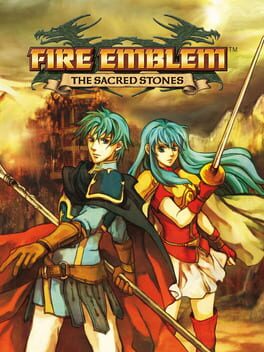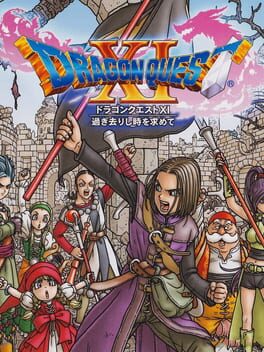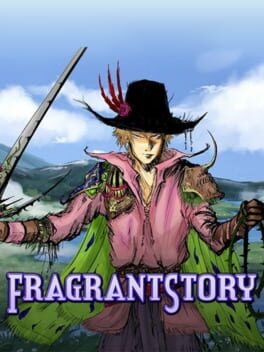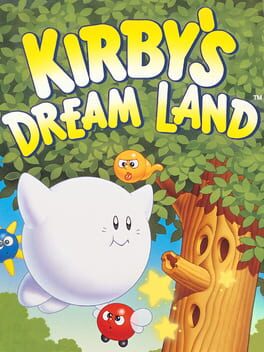Rei366
114 Reviews liked by Rei366
Fire Emblem Gaiden
1992
Notes from my replay:
-Presentation and music is definitely a step up from the previous game, despite only being a year apart.
-Over-world map is neat, but Alm/Celica split is never really utilized for gameplay until the end at the Dragon Volcano.
-Disgusting difficulty spikes at certain points. Alm's first few maps into Act 4 were brutal. Geyse's Map is also a serious roadblock if you don't play around Catria and Palla.
-The story feels more character oriented this time around, rather than Marth just being the conduit for his story to take place. Alm and Celica have a great dynamic, despite this being an ancient game with little-to-no dialogue comparatively.
-Monsters are neat but either way too easy or bullshit hard. Encountering a biggle for the first time actually made me wanna rip my hair out.
-More than ever you NEED to train your pegasus knights up. Falcon Knight is the best class in the game, hands down. The triangle attack is also very, very effective at taking down some of the toughest enemies in the game, as well as getting you out of potentially tight spots.
-This feels like a neat experimentation to build off of the first game, but I can see why they chose to return to Archanea for the third game, as this one was a HUGE departure from the first game, almost feeling like a step backwards in the depth of strategy.
-Presentation and music is definitely a step up from the previous game, despite only being a year apart.
-Over-world map is neat, but Alm/Celica split is never really utilized for gameplay until the end at the Dragon Volcano.
-Disgusting difficulty spikes at certain points. Alm's first few maps into Act 4 were brutal. Geyse's Map is also a serious roadblock if you don't play around Catria and Palla.
-The story feels more character oriented this time around, rather than Marth just being the conduit for his story to take place. Alm and Celica have a great dynamic, despite this being an ancient game with little-to-no dialogue comparatively.
-Monsters are neat but either way too easy or bullshit hard. Encountering a biggle for the first time actually made me wanna rip my hair out.
-More than ever you NEED to train your pegasus knights up. Falcon Knight is the best class in the game, hands down. The triangle attack is also very, very effective at taking down some of the toughest enemies in the game, as well as getting you out of potentially tight spots.
-This feels like a neat experimentation to build off of the first game, but I can see why they chose to return to Archanea for the third game, as this one was a HUGE departure from the first game, almost feeling like a step backwards in the depth of strategy.
Notes for my series replay:
- Serious tone shift for the series up until this point. There are parts of the other games that are dark, but this game feels bleak from the beginning.
- A very nice variety of maps and map objectives, among the most diverse gameplay in the series. This game feels like Kaga was hitting his stride in map design, as the maps range from kinda annoying, to holy shit this is fucking amazing.
- The one thing I REALLY appreciate about Thracia 776 is that the maps mirror the narrative. A bleak situation will be accompanied likely by a map that is equally as bleak and stacked against the player. The map objectives generally reflect this, which is neat, as up until this point they were essentially just seize or rout.
- Another thing, this game is super sandbox-y for a SRPG. Combat potential of units has a relatively low ceiling compared to most games, and as such, OP stats does not equate to facerolling the map (in most cases, save for Ced). Rather, you are required to use the tools at your disposal to solve the problem posed by the chapter, whether it's fog of war, enemies escaping with valuable loot, status staves, etc.
- Almost every single map in this game has a side objective or unique challenge about them. It makes maps memorable and gives the player a nice little dopamine hit when they finally clear a challenging one.
- Thracia 776 implements an interesting capture system, as now any melee units can capture another (non-mounted) melee unit with less constitution and take all of their items. Units with no weapons, or units that are asleep will be captured with no combat initiated. It's high risk, as the capturing unit suffers severe stat penalties for attempting to capture, but gives players a chance to take some of the enticing loot from enemies, creating an interesting economy compared to other entries in the series. I beat my entire replay of this game without buying a single weapon, rather I only bought five door keys in the chapters leading up to the end.
- Capturing can sometimes be unreliable though, as units that have 20 Con cannot be captured, and as I previously mentioned, neither can mounted units. That's why thieves are also very valuable units in Thracia 776, as thieves can yoink just about anything in the game, granted they're faster than the enemy and have more Con than the weapon weighs. It's a really neat system, and makes thieves some of your best units, even if their combat is less than stellar (which it often is).
- Support units are wildly valuable too, as staves are the number one tool at your disposal in Thracia 776. Staves can heal units, warp units, rescue units, unlock chests/doors, inflict statuses, cure statuses, and even steal items from enemies in some circumstances. It wouldn't be exaggeration to say that all of the units that can easily rank A staves in Thracia 776 are among your best units in the game. An abundance in powerful staves in the late game makes this even clearer to a shrewd player.
- Leif is a particularly interesting protagonist. He begins as a kid who has experienced hardship in his life, but doesn't really know what it means to be a leader or a king. He isn't necessarily charismatic, but rather a symbol of liberation that people flock to. His growth over the game makes him potentially one of the most dynamic lords in the series, which is fascinating when you recall his role in the previous game.
- The soundtrack is also really noteworthy. It's not as grandiose as the previous titles, but rather more determined and grounded. A lot of the songs actually sound like marches, save for Leif's theme, which is potentially one of my favorite FE map themes, ever. I think it's also one of the only FE games to have a near defeat theme, which is interesting as a majority of FE soundtracks have a near victory theme.
This game has a threatening aura to some FE newcomers, and I totally understand. It's a daunting game with some really hard and aggravating chapters. I think that being patient and armed with knowledge on some frustrating chapters can remedy alot of the bullshit. When you finally get to understand the workings of Thracia 776 and put in the time to learn it's quirks, it's genuinely one of the best experiences I've had with Fire Emblem as a whole. This is Shouzou Kaga's masterpiece, and it took me way too long to realize it.
- Serious tone shift for the series up until this point. There are parts of the other games that are dark, but this game feels bleak from the beginning.
- A very nice variety of maps and map objectives, among the most diverse gameplay in the series. This game feels like Kaga was hitting his stride in map design, as the maps range from kinda annoying, to holy shit this is fucking amazing.
- The one thing I REALLY appreciate about Thracia 776 is that the maps mirror the narrative. A bleak situation will be accompanied likely by a map that is equally as bleak and stacked against the player. The map objectives generally reflect this, which is neat, as up until this point they were essentially just seize or rout.
- Another thing, this game is super sandbox-y for a SRPG. Combat potential of units has a relatively low ceiling compared to most games, and as such, OP stats does not equate to facerolling the map (in most cases, save for Ced). Rather, you are required to use the tools at your disposal to solve the problem posed by the chapter, whether it's fog of war, enemies escaping with valuable loot, status staves, etc.
- Almost every single map in this game has a side objective or unique challenge about them. It makes maps memorable and gives the player a nice little dopamine hit when they finally clear a challenging one.
- Thracia 776 implements an interesting capture system, as now any melee units can capture another (non-mounted) melee unit with less constitution and take all of their items. Units with no weapons, or units that are asleep will be captured with no combat initiated. It's high risk, as the capturing unit suffers severe stat penalties for attempting to capture, but gives players a chance to take some of the enticing loot from enemies, creating an interesting economy compared to other entries in the series. I beat my entire replay of this game without buying a single weapon, rather I only bought five door keys in the chapters leading up to the end.
- Capturing can sometimes be unreliable though, as units that have 20 Con cannot be captured, and as I previously mentioned, neither can mounted units. That's why thieves are also very valuable units in Thracia 776, as thieves can yoink just about anything in the game, granted they're faster than the enemy and have more Con than the weapon weighs. It's a really neat system, and makes thieves some of your best units, even if their combat is less than stellar (which it often is).
- Support units are wildly valuable too, as staves are the number one tool at your disposal in Thracia 776. Staves can heal units, warp units, rescue units, unlock chests/doors, inflict statuses, cure statuses, and even steal items from enemies in some circumstances. It wouldn't be exaggeration to say that all of the units that can easily rank A staves in Thracia 776 are among your best units in the game. An abundance in powerful staves in the late game makes this even clearer to a shrewd player.
- Leif is a particularly interesting protagonist. He begins as a kid who has experienced hardship in his life, but doesn't really know what it means to be a leader or a king. He isn't necessarily charismatic, but rather a symbol of liberation that people flock to. His growth over the game makes him potentially one of the most dynamic lords in the series, which is fascinating when you recall his role in the previous game.
- The soundtrack is also really noteworthy. It's not as grandiose as the previous titles, but rather more determined and grounded. A lot of the songs actually sound like marches, save for Leif's theme, which is potentially one of my favorite FE map themes, ever. I think it's also one of the only FE games to have a near defeat theme, which is interesting as a majority of FE soundtracks have a near victory theme.
This game has a threatening aura to some FE newcomers, and I totally understand. It's a daunting game with some really hard and aggravating chapters. I think that being patient and armed with knowledge on some frustrating chapters can remedy alot of the bullshit. When you finally get to understand the workings of Thracia 776 and put in the time to learn it's quirks, it's genuinely one of the best experiences I've had with Fire Emblem as a whole. This is Shouzou Kaga's masterpiece, and it took me way too long to realize it.
Notes for my Series Replay:
- The plot feels very safe. Apart from the first game, this feels like the most formulaic story so far. Very standard case of invading neighboring country evolves into conflict with some supernatural beings/dragons. Not saying this is bad, but just very safe for the first FE post Shouzou Kaga.
- The gameplay feels significantly more defined with characters fulfilling specific niches. Classes have different stat caps, and thus characters have specific roles they're more tailored to rather than FE5's sandbox-ish style of gameplay. Also thieves are glorified keys now, as they have little combat potential, can't steal equipped items, and there is a general lack of valuable items worth stealing in FE6.
- Map design is... a thing. Most of the maps in FE6 are questionably large for the lack of enemy density in the normal difficulty. Many of my turns were just spent moving units up to the next encounter, which got to be a little frustrating on some of the more tedious maps. Speaking of which, there are many of those. FE6 maps aren't as large as FE4's maps, but they only sometimes have a gaiden objective, and they're mostly just standard seize maps with very little complexity. Sure, there are some memorable maps, and some notoriously bad maps, but overall I just felt meh on FE6's map design.
- Speaking of gaiden chapters, I have absolutely no clue how the average player is supposed to figure out how to reach them. Thracia is also guilty of this, but this game is mostly just turn limits reqs on maps that are needlessly slow and tedious (I'm looking at you, Chapter 14).
- FE6 somewhat weakened support units and put combat units back in the spotlight compared to FE5. There are still status staves and warp, and the like, but they have been severely hindered from their previous appearance. They have either limited range or accuracy checks to mitigate their performance this time around, and as such, I found myself relying on them as a viable strategy less often.
- But hey guess what, siege tomes and ballista are back. They are not nearly as threatening as in FE5 but still frustrating as hell sometimes. FE6 tends to group together status staves and it makes a somewhat uneventful map turn into a "oh fuck did i bring restore" check. Luckily there are very few maps where this is an issue, but I still felt it was worth noting.
- The one thing I REALLY liked about FE6 was the world building. The nations and their politics made the story of this game really fascinating, and I found myself wanting more of that and less of the dragon stuff to be quite honest. But maybe that's the consequence of playing these games back to back like this.
Overall, I like the vibes of FE6 and the world that it creates, but I feel like the gameplay is just kinda "eh" and after the spectacular gameplay of FE5, I felt a little disappointed. It's a solid game, just a little too safe after what felt like a great leap forward for the series.
- The plot feels very safe. Apart from the first game, this feels like the most formulaic story so far. Very standard case of invading neighboring country evolves into conflict with some supernatural beings/dragons. Not saying this is bad, but just very safe for the first FE post Shouzou Kaga.
- The gameplay feels significantly more defined with characters fulfilling specific niches. Classes have different stat caps, and thus characters have specific roles they're more tailored to rather than FE5's sandbox-ish style of gameplay. Also thieves are glorified keys now, as they have little combat potential, can't steal equipped items, and there is a general lack of valuable items worth stealing in FE6.
- Map design is... a thing. Most of the maps in FE6 are questionably large for the lack of enemy density in the normal difficulty. Many of my turns were just spent moving units up to the next encounter, which got to be a little frustrating on some of the more tedious maps. Speaking of which, there are many of those. FE6 maps aren't as large as FE4's maps, but they only sometimes have a gaiden objective, and they're mostly just standard seize maps with very little complexity. Sure, there are some memorable maps, and some notoriously bad maps, but overall I just felt meh on FE6's map design.
- Speaking of gaiden chapters, I have absolutely no clue how the average player is supposed to figure out how to reach them. Thracia is also guilty of this, but this game is mostly just turn limits reqs on maps that are needlessly slow and tedious (I'm looking at you, Chapter 14).
- FE6 somewhat weakened support units and put combat units back in the spotlight compared to FE5. There are still status staves and warp, and the like, but they have been severely hindered from their previous appearance. They have either limited range or accuracy checks to mitigate their performance this time around, and as such, I found myself relying on them as a viable strategy less often.
- But hey guess what, siege tomes and ballista are back. They are not nearly as threatening as in FE5 but still frustrating as hell sometimes. FE6 tends to group together status staves and it makes a somewhat uneventful map turn into a "oh fuck did i bring restore" check. Luckily there are very few maps where this is an issue, but I still felt it was worth noting.
- The one thing I REALLY liked about FE6 was the world building. The nations and their politics made the story of this game really fascinating, and I found myself wanting more of that and less of the dragon stuff to be quite honest. But maybe that's the consequence of playing these games back to back like this.
Overall, I like the vibes of FE6 and the world that it creates, but I feel like the gameplay is just kinda "eh" and after the spectacular gameplay of FE5, I felt a little disappointed. It's a solid game, just a little too safe after what felt like a great leap forward for the series.
Notes from my series replay:
- Super ambitious title, really feels like Kaga was hitting his stride here. I feel like this is the biggest departure from what they had up until this point and it pays off.
-Maps are much larger and generally get shafted in terms of tight gameplay design in favor of grand sweeping encounters between massive groups of forces. Shorter, sweeter maps are lost in favor of grand conflicts across entire nations, as a result the game feels MASSIVE.
- Another side-effect of the change in map design is the dominance of the mounted cavalry units. IntSys cut back on the fliers in this game, now only sporting one or two per generation, but gives the player at least 5-10 mounted units per generation. This was most likely for ease of map design for less potential cheese than FE1-3 had with fliers. Footlocked units often get left in the dust on the larger maps, so I found myself leaving them to defend the castle for game efficiency.
- Staves have found themselves massively nerfed in terms of freedom and jank. They sport a wider range of use at the cost of cheesing the game.
-The story revolves around a different world and lore than the first 3 titles, quite frankly jumping into a world with greater depth than the series had ever had before in terms of world and character building. Each map features individual character conversations beyond just recruitment purposes, and it feels like the distant predecessor to support conversations in later FE titles.
-The holy blood and inheritance system is super fascinating and makes every playthrough feel like a different game. Granted it can be a little tedious to keep the units close enough to pair them up in the first generation, the second gen has INSANE depth of gameplay and strategy for subsequent replays as a result. This feels like the most well thought out child system the series has had thus far, and it feels super well integrated into the story as well.
- Castle towns are a fascinating addition too, making each castle feel like a well earned checkpoint in the maps, granting units access to shops, the arena, and a strange step backwards from the trading system in the form of the pawnbroker.
-The game is designed around each map taking the player multiple play sessions to complete. There's an autosave feature, as well as the ability to drop a hard save at the top of every turn. The maps take upwards of an hour, but these features alleviate that aspect for players not wanting to sink hours into each play session, making the game far more accessible than most despite the daunting map size.
-Small annoyance, but they didn't give a fuck with status staves in the last couple maps because there are sleep and silence staff users EVERYWHERE. It was becoming a little tedious to deal with to some degree, but just having the knowledge to bring a restore staff makes it bearable.
Tl;dr the game has a lot of things that it improves, some awkward jank in a lot of places, and other minor annoyances with pairing and enemy placement, etc. That being said, the game has a lot of heart and a beautiful story with some great characters. I still feel confident ranking it among my favorite games of all time.
- Super ambitious title, really feels like Kaga was hitting his stride here. I feel like this is the biggest departure from what they had up until this point and it pays off.
-Maps are much larger and generally get shafted in terms of tight gameplay design in favor of grand sweeping encounters between massive groups of forces. Shorter, sweeter maps are lost in favor of grand conflicts across entire nations, as a result the game feels MASSIVE.
- Another side-effect of the change in map design is the dominance of the mounted cavalry units. IntSys cut back on the fliers in this game, now only sporting one or two per generation, but gives the player at least 5-10 mounted units per generation. This was most likely for ease of map design for less potential cheese than FE1-3 had with fliers. Footlocked units often get left in the dust on the larger maps, so I found myself leaving them to defend the castle for game efficiency.
- Staves have found themselves massively nerfed in terms of freedom and jank. They sport a wider range of use at the cost of cheesing the game.
-The story revolves around a different world and lore than the first 3 titles, quite frankly jumping into a world with greater depth than the series had ever had before in terms of world and character building. Each map features individual character conversations beyond just recruitment purposes, and it feels like the distant predecessor to support conversations in later FE titles.
-The holy blood and inheritance system is super fascinating and makes every playthrough feel like a different game. Granted it can be a little tedious to keep the units close enough to pair them up in the first generation, the second gen has INSANE depth of gameplay and strategy for subsequent replays as a result. This feels like the most well thought out child system the series has had thus far, and it feels super well integrated into the story as well.
- Castle towns are a fascinating addition too, making each castle feel like a well earned checkpoint in the maps, granting units access to shops, the arena, and a strange step backwards from the trading system in the form of the pawnbroker.
-The game is designed around each map taking the player multiple play sessions to complete. There's an autosave feature, as well as the ability to drop a hard save at the top of every turn. The maps take upwards of an hour, but these features alleviate that aspect for players not wanting to sink hours into each play session, making the game far more accessible than most despite the daunting map size.
-Small annoyance, but they didn't give a fuck with status staves in the last couple maps because there are sleep and silence staff users EVERYWHERE. It was becoming a little tedious to deal with to some degree, but just having the knowledge to bring a restore staff makes it bearable.
Tl;dr the game has a lot of things that it improves, some awkward jank in a lot of places, and other minor annoyances with pairing and enemy placement, etc. That being said, the game has a lot of heart and a beautiful story with some great characters. I still feel confident ranking it among my favorite games of all time.
Notes for my series replay:
- I'm just going to get it out of the way in this bullet because we're all thinking it: the first ten chapters of this game are fucking unbearable. Most Fire Emblem newcomers won't play this game first, so the fucking TEN tutorial levels that the game forces down your throat is obnoxious. For western players in 2003, I'm sure this was a necessary evil but replaying it is a tough pill to swallow. The story is whatever and the maps are baby food. That's about it. You COULD circumvent these levels by downloading a save off of GameFAQs, but I'd rather just have the tutorial be toggle-able.
- Getting to the actual game, however, I found that the story was actually semi-interesting at the start. Eliwood's tale of searching out his missing father was a new-ish spin on the classic case of FE daddy issues. I also found Hector and Eliwood's dynamic pretty endearing, and Lyn was also solid, but I felt a little less developed in the story than the other two. The story actually builds on FE6's lore of the Eight Legends pretty well, too. It's not the most revolutionary FE story there is, but it's solid for what it's trying to do.
- This game plays like baby mode FE6. I found myself blazing through maps, as there are very few threatening obstacles, other than a slew of underwhelming and generally non-threatening enemies. I didn't grind or arena abuse at all (I haven't been for this replay in favor of playing the intended way) but I still found most of the tools the game gave me to be far more than adequate to handle the chapters. This game doesn't shower you with pre-promotes in the mid game like FE6, but it does give you plenty of promotion items to buff your party early.
- The map design in FE7 is not as frustrating as it was in FE6, but I found them to suffer from the same case of tedious walking simulator. There were less gaiden objectives, too, so I found myself playing with my brain off essentially. Fliers are easily abusable in this entry, as the number of ballistas is laughable compared to FE5/6. There is very few instances of thief utility outside of doors/chests once again, so planning is just outfitting weapons and staves onto your team for the most part.
- The soundtrack is solid, I would say so far middle of the pack, that will change based on the later entries to come, but I think that this game still has some bangers. I love that "Campaign of Fire" uses part of "The Last Dragon" from FE6, as well as some re-use of classic FE tracks like "Knight's Vow" and "Together We Ride."
There isn't much to say about FE7 that I didn't really say about FE6. It feels like a good enough prequel FE6 game, minus the difficulty and, for lack of a better word, bullshit. I will lend to its' credit that the game has both Eliwood/Hector stories to tackle, AND their hard modes to add to the replayability, but honestly I found myself satisfied with just the one run through I had. In terms of Fire Emblem games, this feels like fast food, as it's not super high quality, but it is a quick hit of Fire Emblem, as the chapters tend to be really quick due to the lack of overall difficulty and depth compared to previous entries.
- I'm just going to get it out of the way in this bullet because we're all thinking it: the first ten chapters of this game are fucking unbearable. Most Fire Emblem newcomers won't play this game first, so the fucking TEN tutorial levels that the game forces down your throat is obnoxious. For western players in 2003, I'm sure this was a necessary evil but replaying it is a tough pill to swallow. The story is whatever and the maps are baby food. That's about it. You COULD circumvent these levels by downloading a save off of GameFAQs, but I'd rather just have the tutorial be toggle-able.
- Getting to the actual game, however, I found that the story was actually semi-interesting at the start. Eliwood's tale of searching out his missing father was a new-ish spin on the classic case of FE daddy issues. I also found Hector and Eliwood's dynamic pretty endearing, and Lyn was also solid, but I felt a little less developed in the story than the other two. The story actually builds on FE6's lore of the Eight Legends pretty well, too. It's not the most revolutionary FE story there is, but it's solid for what it's trying to do.
- This game plays like baby mode FE6. I found myself blazing through maps, as there are very few threatening obstacles, other than a slew of underwhelming and generally non-threatening enemies. I didn't grind or arena abuse at all (I haven't been for this replay in favor of playing the intended way) but I still found most of the tools the game gave me to be far more than adequate to handle the chapters. This game doesn't shower you with pre-promotes in the mid game like FE6, but it does give you plenty of promotion items to buff your party early.
- The map design in FE7 is not as frustrating as it was in FE6, but I found them to suffer from the same case of tedious walking simulator. There were less gaiden objectives, too, so I found myself playing with my brain off essentially. Fliers are easily abusable in this entry, as the number of ballistas is laughable compared to FE5/6. There is very few instances of thief utility outside of doors/chests once again, so planning is just outfitting weapons and staves onto your team for the most part.
- The soundtrack is solid, I would say so far middle of the pack, that will change based on the later entries to come, but I think that this game still has some bangers. I love that "Campaign of Fire" uses part of "The Last Dragon" from FE6, as well as some re-use of classic FE tracks like "Knight's Vow" and "Together We Ride."
There isn't much to say about FE7 that I didn't really say about FE6. It feels like a good enough prequel FE6 game, minus the difficulty and, for lack of a better word, bullshit. I will lend to its' credit that the game has both Eliwood/Hector stories to tackle, AND their hard modes to add to the replayability, but honestly I found myself satisfied with just the one run through I had. In terms of Fire Emblem games, this feels like fast food, as it's not super high quality, but it is a quick hit of Fire Emblem, as the chapters tend to be really quick due to the lack of overall difficulty and depth compared to previous entries.
Notes for my series replay:
- Pretty par for the course on GBA Fire Emblems in terms of presentation, looks a little bit more polished than the other two in some areas but ultimately plays the same.
- First game since Gaiden to have a world map, kinda neat throwback to Gaiden but just like in Gaiden it's mostly novelty and not super meaningful. If we're being technical, it actually has less purpose than Gaiden because it's a straight line and you never really have to deal with monster encounters unless you go to grind. Gaiden at least had branching paths in some cases that took you to different dungeons and maps. There are like 3 dungeons in FE8 and they don't really reward you with much of anything except for post game content.
- The easiest game I have played so far, even easier than FE7. I played Ephraim's route for my replay, and even the hardest chapter in that (chapter 14) was still mildly frustrating due to poor luck with status staves.
- Speaking of which, this must be the most straightforward entry thus far, as there are maybe like 3 maps with ballistas, occasionally siege tomes, and mostly just reinforcements to worry about, but they don't move on EP so it's not a huge deal. Yeah there are status staves, but their accuracy is kinda shoddy and you get PLENTY of restore staves, so proper positioning and burning the staves is easy enough.
- Given what I just mentioned, maps are hardly memorable or impactful. They feel pretty devoid of any real thought except for enemy placement and general setting. The bravest Sacred Stones gets with map design is putting you on three small boats in fog of war. Frustrating, sure, but not exactly engaging.
- To give credit where it's due, FE8 has an absolute slapper of a soundtrack. It goes extremely hard for absolutely no reason in some tracks. "Powerful Foe" is a awesome boss theme, "Truth, Despair, and Hope" fucking blew me out of the water the first time I heard it and it still makes me get hyped even on replays, and of course "Prince of Despair" is my favorite GBA main antag theme. In fact, of the three GBA titles, I would say either Sacred Stones has the best OST overall. It starts very mid, but picks up in the mid game and starts to blow your socks off.
- My last critique of Sacred Stones is that the cast of characters is kinda sleepy. I think there are a few awesome standouts like Joshua and Cormag, but otherwise I feel like this game has the most white bread cast up to this point, as without farming supports for dozens of turns, I get almost no characterization from most of the cast when they're recruited. And the few that you do get characterization from are just like knightly types, which is fine but it gets old after a few of them. None can touch the GOAT Seth, granted.
Overall, the best way I can describe Sacred Stones is that it has neat OST and presentation, but man is the game bland. It has a few neat departures from the standard, but ultimately they're making an already too easy game even easier. For me, I opted out of those features for the most part, and I felt like even as a standard FE game this falls a little flat in most places. Ephraim is funny though because he feels like a Michael Bay movie character in Fire Emblem which is kinda epic.
- Pretty par for the course on GBA Fire Emblems in terms of presentation, looks a little bit more polished than the other two in some areas but ultimately plays the same.
- First game since Gaiden to have a world map, kinda neat throwback to Gaiden but just like in Gaiden it's mostly novelty and not super meaningful. If we're being technical, it actually has less purpose than Gaiden because it's a straight line and you never really have to deal with monster encounters unless you go to grind. Gaiden at least had branching paths in some cases that took you to different dungeons and maps. There are like 3 dungeons in FE8 and they don't really reward you with much of anything except for post game content.
- The easiest game I have played so far, even easier than FE7. I played Ephraim's route for my replay, and even the hardest chapter in that (chapter 14) was still mildly frustrating due to poor luck with status staves.
- Speaking of which, this must be the most straightforward entry thus far, as there are maybe like 3 maps with ballistas, occasionally siege tomes, and mostly just reinforcements to worry about, but they don't move on EP so it's not a huge deal. Yeah there are status staves, but their accuracy is kinda shoddy and you get PLENTY of restore staves, so proper positioning and burning the staves is easy enough.
- Given what I just mentioned, maps are hardly memorable or impactful. They feel pretty devoid of any real thought except for enemy placement and general setting. The bravest Sacred Stones gets with map design is putting you on three small boats in fog of war. Frustrating, sure, but not exactly engaging.
- To give credit where it's due, FE8 has an absolute slapper of a soundtrack. It goes extremely hard for absolutely no reason in some tracks. "Powerful Foe" is a awesome boss theme, "Truth, Despair, and Hope" fucking blew me out of the water the first time I heard it and it still makes me get hyped even on replays, and of course "Prince of Despair" is my favorite GBA main antag theme. In fact, of the three GBA titles, I would say either Sacred Stones has the best OST overall. It starts very mid, but picks up in the mid game and starts to blow your socks off.
- My last critique of Sacred Stones is that the cast of characters is kinda sleepy. I think there are a few awesome standouts like Joshua and Cormag, but otherwise I feel like this game has the most white bread cast up to this point, as without farming supports for dozens of turns, I get almost no characterization from most of the cast when they're recruited. And the few that you do get characterization from are just like knightly types, which is fine but it gets old after a few of them. None can touch the GOAT Seth, granted.
Overall, the best way I can describe Sacred Stones is that it has neat OST and presentation, but man is the game bland. It has a few neat departures from the standard, but ultimately they're making an already too easy game even easier. For me, I opted out of those features for the most part, and I felt like even as a standard FE game this falls a little flat in most places. Ephraim is funny though because he feels like a Michael Bay movie character in Fire Emblem which is kinda epic.
Fragrant Story
2022
An RPG entirely reliant on luck, that's 15 minutes long and was rushed out to be one of the last 3DS games only to be finished later with updates. You buy it to buy it and own a rare 3DS game. That's what I bought it for. To say i own it. But, as a game made by one guy for charity it's FINE. Doesn't make it a good game though.
Kirby's Dream Land
1992
I've seen some people who consider the original Kirby's Dream Land to be one of the weaker platformers in the pink puffball's catalog, and I couldn't disagree more. It's one of the most impeccably designed action games of the 8-bit era; it's based around a novel concept (swallowing and spitting out enemies) that is explored to its fullest potential across stages that have little to no wasted space or redundancy while continuously guiding the player through setpieces that never interrupt the game flow. It looks and sounds excellent and distinct, and upon beating the game you can replay it with more challenging obstacles and bosses, along with being able to perform challenge runs, and the incredibly short length guarantees that, no matter how many times you replay it, it'll never get tedious. Sure, later games would introduce far more depth with copy abilities and collectibles and grandiose adventures, but taken on its own instead of in relation to the games from Adventure onwards, Dream Land 1 is still a tight and polished experience that I could recommend to anyone even 30 years after its initial release.
